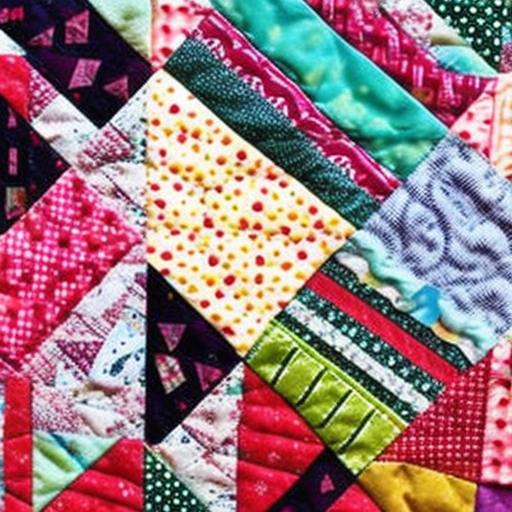
In the world of quilting, strip piecing is a technique beloved by many quilters. It is a time-saving method that allows you to quickly sew together long strips of fabric, which can then be cut into smaller segments to create beautiful quilt patterns. Not only is strip piecing efficient, but it also opens up a whole range of design possibilities. Whether you are a beginner or an experienced quilter, strip piecing can breathe new life into your quilting projects.
Why choose strip piecing?
Strip piecing is highly favored by quilters for several reasons. Firstly, it saves time by reducing the number of individual fabric pieces that need to be cut and sewn together. By sewing long strips, you can create larger sections of your quilt top in a fraction of the time it would take with traditional piecing methods.
Secondly, strip piecing allows for more accuracy when sewing complex patterns. With strips sewn together, you have a continuous fabric surface to work with. This makes it easier to align seams, match corners, and maintain accurate measurements throughout the quilt top.
Lastly, strip piecing greatly expands your design possibilities. By combining different fabric strips, you can create visually stunning effects such as diagonals, chevrons, waves, and many more. It adds a dynamic element to your quilting projects and allows you to experiment with color and pattern placement.
Strip piecing technique
The process of strip piecing involves sewing fabric strips together, pressing the seams, and then cutting the sewn strips into smaller segments. Follow these steps to get started on your strip piecing journey:
- Select your fabric strips: Choose fabrics that complement each other and suit your desired quilt pattern. It is recommended to use strips of the same width for consistency.
- Arrange the fabric strips: Lay out your strips in the desired order and orientation, creating a pleasing color and pattern arrangement.
- Sew the fabric strips: Sew the strips together along their long edges, using a quarter-inch seam allowance. Use pins or fabric clips to secure the strips in place before sewing.
- Press the seams: Press the seam allowances to one side, ensuring they lie flat and create a smooth surface.
- Cut the sewn strips: Once the strips are pressed, use a rotary cutter and ruler to cut the sewn strips into smaller segments as specified by your quilt pattern.
- Arrange and sew the segments: Arrange the cut segments according to your chosen design and start sewing them together to form your quilt top.
- Continue piecing the quilt top: Repeat the sewing process until all the segments are sewn together, creating your desired quilt pattern.
- Finish your quilt: Layer your pieced quilt top with batting and backing fabric, quilt as desired, and bind the edges to complete your quilt.
Design possibilities with strip piecing
Strip piecing allows quilters to explore various design possibilities that can transform a simple pattern into a visually striking masterpiece. Here are a few popular strip piecing designs:
- Log Cabin: The classic Log Cabin pattern uses strips of fabric that radiate around a central square. Strip piecing makes it much faster to construct each log, allowing for quick assembly of this traditional design.
- Bargello: Bargello quilts create mesmerizing, flowing designs using strips of fabric. By using strip piecing, quilters can easily achieve the smooth gradients and color shifts that define Bargello patterns.
- Strip Quilts: These quilts create a dramatic visual impact by using strips of fabric of varying widths and colors. Strip piecing is the perfect technique for creating strip quilts, as it allows for precise seam alignment and efficient construction.
Strip piecing is a versatile and time-saving technique that can enhance your quilting experience. Its efficiency, accuracy, and design possibilities make it an attractive choice for both beginner and experienced quilters. So why not give strip piecing a try? Unleash your creativity and explore the world of quilt patterns strip piecing!

Love Strip Piecing!
Such a great way to add interesting patterns and color to a quilt! #stripquiltlove
Agreed!! Strip Piecing is such a fun and easy way to create unique quilts!
Strip Piecing is an amazing technique not only for experienced quilters but also for beginners – it can give any quilt a wonderful boost of color and personality! #lovethestripes
Yes totally! Strip Piecing is my favorite technique for making quick quilts!
Strip Piecing is a great way to add flair and personality to a quilt – it’s so easy to make intricate designs in no time at all! #stripesmakethequilt
Absolutely! Strip Piecing is a fantastic way to add sophistication and detail to quilt projects. The beautiful patterns and shapes you can create makes quilting a truly enjoyable experience! #quiltstrips
Absolutely! Strip Piecing is a great way to add both detail and speed to quilt projects, creating a beautiful design in no time! #stripquiltingftw
Absolutely! Strip Piecing can bring a quilt to life with its vibrant colors and fun pattern designs – it makes quilting so much more enjoyable! #stripesofjoy
Absolutely! Strip Piecing is an incredibly versatile technique – from creating intricate detail to adding pops of bright color, it’s a must for any quilter’s arsenal! #morestripeplz
Agreed! Strip Piecing is one of the best techniques for adding fun patterns and colors to quilt designs. With its easy steps, you’ll have a stunning quilt in no time. #strippin4quilts
I completely agree! Strip Piecing is an incredible technique that can really transform any quilt project with its intricate designs and bold colors. #stripesofcolor